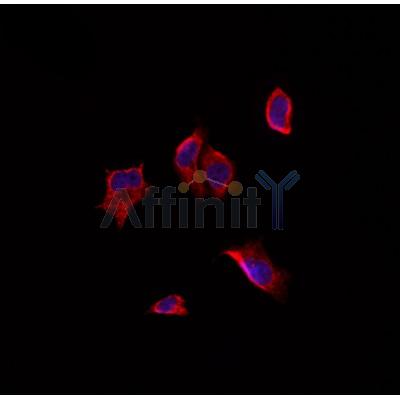AKAP5 Antibody - #DF3129
| Product: | AKAP5 Antibody |
| Catalog: | DF3129 |
| Description: | Rabbit polyclonal antibody to AKAP5 |
| Application: | WB IF/ICC |
| Reactivity: | Human, Mouse |
| Prediction: | Pig, Horse, Dog |
| Mol.Wt.: | 47 KD; 47kD(Calculated). |
| Uniprot: | P24588 |
| RRID: | AB_2835506 |
Related Downloads
Protocols
Product Info
*The optimal dilutions should be determined by the end user. For optimal experimental results, antibody reuse is not recommended.
*Tips:
WB: For western blot detection of denatured protein samples. IHC: For immunohistochemical detection of paraffin sections (IHC-p) or frozen sections (IHC-f) of tissue samples. IF/ICC: For immunofluorescence detection of cell samples. ELISA(peptide): For ELISA detection of antigenic peptide.
Cite Format: Affinity Biosciences Cat# DF3129, RRID:AB_2835506.
Fold/Unfold
A kinase (PRKA) anchor protein 5; A kinase anchor protein 5; A kinase anchor protein 79kDa; A kinase anchoring protein 75/79; A-kinase anchor protein 5; A-kinase anchor protein 79 kDa; AKAP 5; AKAP 75; AKAP 79; AKAP-5; Akap5; AKAP5_HUMAN; AKAP75; AKAP79; cAMP dependent protein kinase regulatory subunit II high affinity binding protein; cAMP-dependent protein kinase regulatory subunit II high affinity-binding protein; H21;
Immunogens
A synthesized peptide derived from human AKAP5, corresponding to a region within N-terminal amino acids.
Predominantly in the cerebral cortex and the postsynaptic densities of the forebrain, and to a lesser extent in adrenal medulla, lung and anterior pituitary.
- P24588 AKAP5_HUMAN:
- Protein BLAST With
- NCBI/
- ExPASy/
- Uniprot
METTISEIHVENKDEKRSAEGSPGAERQKEKASMLCFKRRKKAAKALKPKAGSEAADVARKCPQEAGASDQPEPTRGAWASLKRLVTRRKRSESSKQQKPLEGEMQPAINAEDADLSKKKAKSRLKIPCIKFPRGPKRSNHSKIIEDSDCSIKVQEEAEILDIQTQTPLNDQATKAKSTQDLSEGISRKDGDEVCESNVSNSTTSGEKVISVELGLDNGHSAIQTGTLILEEIETIKEKQDVQPQQASPLETSETDHQQPVLSDVPPLPAIPDQQIVEEASNSTLESAPNGKDYESTEIVAEETKPKDTELSQESDFKENGITEEKSKSEESKRMEPIAIIITDTEISEFDVTKSKNVPKQFLISAENEQVGVFANDNGFEDRTSEQYETLLIETASSLVKNAIQLSIEQLVNEMASDDNKINNLLQ
Predictions
Score>80(red) has high confidence and is suggested to be used for WB detection. *The prediction model is mainly based on the alignment of immunogen sequences, the results are for reference only, not as the basis of quality assurance.
High(score>80) Medium(80>score>50) Low(score<50) No confidence
Research Backgrounds
May anchor the PKA protein to cytoskeletal and/or organelle-associated proteins, targeting the signal carried by cAMP to specific intracellular effectors. Association with to the beta2-adrenergic receptor (beta2-AR) not only regulates beta2-AR signaling pathway, but also the activation by PKA by switching off the beta2-AR signaling cascade.
Palmitoylation at Cys-36 and Cys-129 plays a key role in targeting to lipid rafts.
Membrane>Lipid-anchor.
Note: Associates with lipid rafts.
Predominantly in the cerebral cortex and the postsynaptic densities of the forebrain, and to a lesser extent in adrenal medulla, lung and anterior pituitary.
RII-alpha binding site, predicted to form an amphipathic helix, could participate in protein-protein interactions with a complementary surface on the R-subunit dimer.
The N-terminal region, which is highly basic, is required for interaction with calmodulin.
Restrictive clause
Affinity Biosciences tests all products strictly. Citations are provided as a resource for additional applications that have not been validated by Affinity Biosciences. Please choose the appropriate format for each application and consult Materials and Methods sections for additional details about the use of any product in these publications.
For Research Use Only.
Not for use in diagnostic or therapeutic procedures. Not for resale. Not for distribution without written consent. Affinity Biosciences will not be held responsible for patent infringement or other violations that may occur with the use of our products. Affinity Biosciences, Affinity Biosciences Logo and all other trademarks are the property of Affinity Biosciences LTD.

